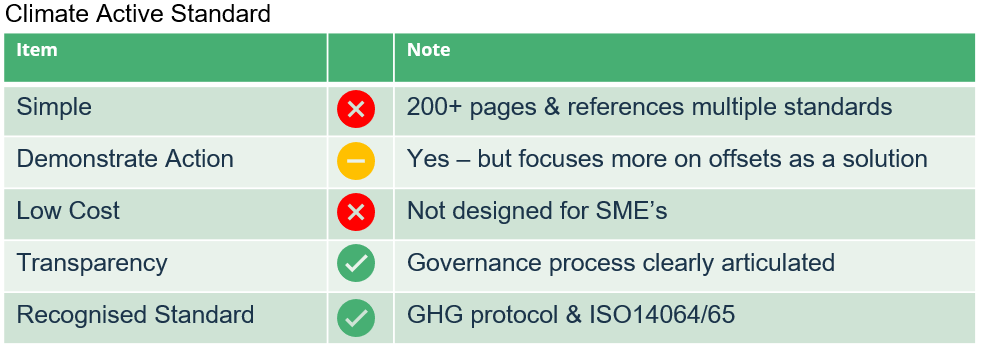Is The Climate Active Program for Small – Medium Business? You Decide!
You may or may not heard of the Climate Active Program. It’s an Australian Government program that sets out to ‘support’ national climate policy by driving voluntary climate action (i.e. action by businesses and organisations to avoid, reduce and offset emissions without a ‘legislated’ requirement to do so).
At face value, this sounds great. But who is this program really for? and what’s involved?
This article looks at the Climate Active Standard from a Small – Medium business lens. In a time where costs are rising and pressures are on, Climate Action is another thing that businesses need to think about, and for some, it’s just too hard. In saying this every single business has some emissions and contributes to the overall impact on our climate. The aim of any standard should be to provide a solution that makes taking positive action to reduce emissions so easily accessible and low cost a business can get on board:
- Be so simple anyone can participate without having a degree in climate science in order to understand it
- Be able to easily demonstrate positive action without the fear of greenwashing
- Be so low cost that it doesn’t become a hindrance to the business itself
- Provide a level of transparency so it delivers trust in action
- Meet recognised standards providing credibility (GHG Protocol – ISO14000 series)
So does Climate Active deliver on the five (5) key points above?
We will cut straight to the point and say in our opinion Climate Active addresses in part point 2 and delivers on points 4 & 5. The remainder of this article explores what’s involved, how long it takes and what are the typical costs for a business.
Climate Active states on its site they now have 700 businesses participating in the program, Australia currently has more than 2.4 million businesses (of which 98% are classified as small to medium with under 20 employees) which equates to a participation rate of 0.29%, this is pretty low, why?
Let’s start by summarising the Climate Active Program:
Overview:
The Climate Active Program is an Australian Government initiative that encourages businesses and organizations to take voluntary action to reduce their carbon emissions and transition to a more sustainable and low-carbon future. This program was formerly known as the National Carbon Offset Standard (NCOS) and was rebranded as Climate Active in 2019 to better reflect its broader goals. The Standard makes reference to the GHG Protocol and ISO 1400 series standards as the foundational approach to lessen negative impact.
Key Objectives:
- Emission Reduction: The primary goal of the program is to help organisations reduce their greenhouse gas emissions and achieve carbon neutrality. This is achieved through activities such as energy efficiency improvements, renewable energy use, and carbon offsetting.
- Certification: Businesses and organisations that meet the program’s criteria can become Climate Active Certified. This certification serves as a way to demonstrate a commitment to environmental responsibility.
- Carbon Offsetting: For emissions that cannot be eliminated through reductions, participants can invest in carbon offset projects approved by the program. These projects capture or reduce an equivalent amount of emissions, balancing out the organisation’s carbon footprint.
Eligibility:
The Climate Active Program is open to any business or government entities, and not-for-profit organisations. It is voluntary, and participants can engage in different levels of commitment depending on their environmental goals.
Stated Benefits:
- Environmental Responsibility: Participation in the program showcases a commitment to addressing climate change and reducing the organisation’s carbon footprint.
- Certification: Climate Active use Certification badges as a symbol of carbon neutrality.
- Marketability: Many consumers and stakeholders prioritise sustainability, making Climate Active certification a way to advertise your action.
- Access to Knowledge: Participants can access resources and guidance to help them make informed decisions about emissions reduction and offsetting.
What’s Involved?
We are not going to pull any punches here. If you intend doing this yourself, be prepared it’s complex, time-consuming, and costly, the other alternative is to hire a consultant to do this for you – see the costs section.
After going through the guidance material your business will need to complete the following: (a side note here the guidance material is 200-plus pages):
- Emission Measurement and Reporting: Accurately measure and report your emissions is a fundamental requirement for certification. Businesses must collect and analyse data from various sources, this can be complex and a resource-intensive process.
- Carbon Footprint Assessment: Calculating the organisation’s carbon footprint entails accounting for emissions from all scopes, including direct (Scope 1), energy-related (Scope 2), and indirect (Scope 3) emissions.
- Setting Reduction Targets: Once emissions are quantified, businesses need to set realistic and ambitious reduction targets.
- Implementation of Mitigation Strategies: Taking effective measures to reduce emissions requires planning and investment in energy-efficient technologies, renewable energy sources, and sustainable practices.
- Carbon Offset Selection: When emissions cannot be completely eliminated, businesses may need to invest in carbon offset projects. Finding a retailer that can do this for you is not easy, selecting suitable projects and ensuring they align with program requirements can be intricate, you also have the cost of the offsets.
- Data Verification: Climate Active certification involves third-party verification to ensure accuracy and credibility. Preparing for and undergoing this verification will require associated documentation and the hiring of consultants.
- Cost Considerations: Becoming certified will require, an annual license fee from Climate Active, third-party consultants to verify the measurement, carbon offsets for unavoidable emissions, and capital for emissions reduction initiatives. Balancing these costs with the benefits of certification can be a challenge for businesses.
- Change Management: Implementing sustainability measures and fostering a culture of environmental responsibility may require a shift in organisational culture and practices.
- Long-Term Commitment: Maintaining carbon neutrality is an ongoing effort, and businesses must continuously monitor and adjust their strategies to remain certified.
The overall certification process can be illustrated below:
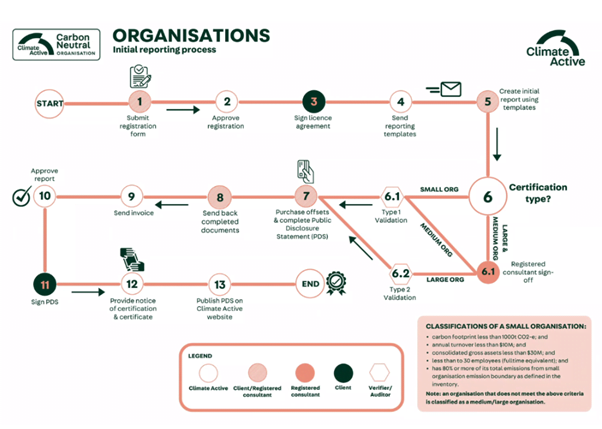
How long does all this take?
This can vary depending on the size of your business and type of certification. In our experience, the longest part is usually the data collection from your organisation. You should allow 4-6 weeks for this, and if you have this readily available a competent consultant should be able to validate in 2-3 weeks. All relevant documentation needs to be completed and sent to the Climate Active team, once an application is completed, a decision will be made and this can take up to six weeks.
So for an optimised result the duration would take a minimum of 3-4 months. Some businesses have reported that their initial Climate Active Certification takes up to 6-12 months.
What’s the Cost?
Costs are typically annualised so you will need to budget for this each year.
License Fees
Your business will need to sign a license agreement with CLimate Active in order to use or reference the certification. The Climate Active annual license fee to maintain certification and use the Climate Active Badge is:
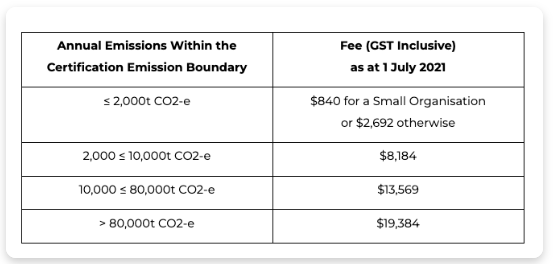
The fees undergo an annual increase of 2.5% on 1st July each year, unless the department of Industry, Science, Energy and Resources publishes different fees through an updated license agreement.
Consultant costs
The following are ball park figures in which we have established based on our industry knowledge and experience and what organisations have reported to us paying for qualified Climate Active consultants to verify business emissions.
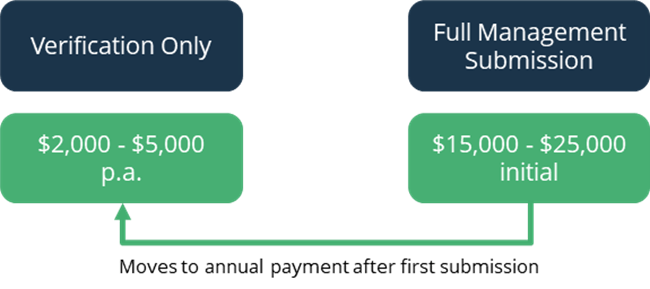
Carbon Offset Costs
Its likely as a business you will not be able to eliminate all emissions, so with the unavoidable emissions to achieve Climate Active Certification carbon offsets will need to be purchased. We have supplied a range of offset costs depending on the project and the source of the offset. Noting that Climate Active excludes certain types of projects and requires at this point a minimum vintage of 2012.
Offset Costs assuming a small business has 65t CO2 p.a. the combined pricing assumes 50% of the offsets are Australian and 50% are International at mid range pricing.
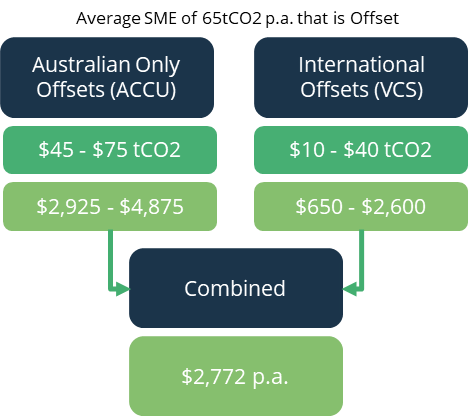
So let’s run an example of a Small Business wanting to be Climate Active with an average of 65tCO2 measured per year:
- Verification Consultants = $3,000
- Offsets (Mid-range costs combined) = $2,772
- Climate Active License Fee = $845
- Your Time = ?
- Total annual costs = $6,617 excluding time
A full management scenario would add another ~$10,000 to this initially.
As a small to medium business is this something that is easily slotted into the budget each year?
In Summary
Climate Active will be for some businesses typically the larger of the medium size organisations and large organisations. In our opinion, there are a couple of key things that really need to be addressed if the Government wants the participation of small and medium businesses.
- The program needs to be simplified, at the moment it is too much for SMEs to understand and the standard fosters a consultant model which maintains the complexity of a specialised service
- A consultant model drives up costs placing barriers in front of business owners
- The focus is on an offset model where a business can still become Climate Active Certified without changing anything, just by offsetting its measured emissions into projects the program deems acceptable
- Why create another standard ‘Climate Active’ when it references already recognised international standards as the GHG protocol and ISO 14000 series
Recapping on the five (5) key points raised at the beginning, in our opinion how does Climate Active deliver on these?
Is there a Better Way?
As we mentioned our lens on this has been from an SME perspective so if Climate Active is not for your business does this mean your business can’t adopt sustainable values, be recoginsed and do something positive?
The whole point of Climate Actives, it is to lessen the negative impact on the environment by:
- Emissions Reduction
- Certification /Commitment
- Carbon Offsetting
What if there was a way to do this, still align with the Climate Active reference standards (GHG Protocol & ISO 14000 standards) without all the complexity, cost and time associated with this process?
Well there is….
Want to find out how your business can get a verified level assessment which includes:
- Emissions measured and verified – provided in a detailed report
- Access to a centralised software platform for all your climate action
- Customised emissions reduction management plans
- Automated reporting demonstrating your impact
- Access to like-minded community
- Create / Join and customise groups to share collaborate and join other groups,
- Visibility across your entire supply chain and,
- Many more features all for less than the Climate Active License fee of $840 p.a.
Contact us below for a free 30 min consultation.

